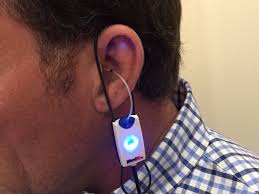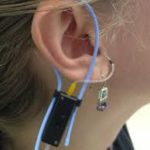Another name of REM is probe microphone measurement. It is a test conducted by the hearing aid provider which ensures that individual hearing aid provides the right amount of sound to their eardrum. When new hearing aid programmed in your ear. Your hearing aid provider inserts a tiny device in your ear canal near to the eardrum. This measures the sound at your eardrum to check your hearing aid applying the appropriate gain at each frequency.
If you need more information or you have a question regarding Real Ear Measurement, you can discuss it with our HearingSol healthcare professionals, just give us a call on +91-9327901950. We are always here to help you.
Facts of real-ear measurement:
- First, Rastronics produce real ear management tool.
- In 1980s first computerized probe-tube microphone system came into existence.
- Steen Rasmussen developed Rastronics CCI-10 in Denmark.
- First placed in the U.S market by Nielsen and Rasmussen in 1984.
- Silicone tube attached this system to the microphone. That eliminated the need of placing the microphone itself in the ear canal.
- Another name of REM is paradoxical sleep.
- During REM blind people can move their eyes.
- It innovatively enhances the way of thinking. Also, helps in problem-solving.
- It plays a vital role in emotional regulation.
- During REM you are paralyzed.
- For the development of the brain, REM is vital.
Method to perform real ear measurement(REM):
- The first audiologist examines the ear canal with an otoscope. To check no earwax or other substance is interfere with placing a probe tube.
- A tube is placed with the tip approx 6 mm (1/4 inch) from the tympanic membrane.
- Then hearing aid is put in place.
- The real-ear measurement tool performs a test from a loudspeaker. That is situated 12–15 inches from the patient head.
- Than measure output in the ear canal to determine how much amplification hearing aid providing.
Basic terminology and procedures of real-ear measurement
Probe Tube Calibration – Calibrate the probe tube before conducting real-ear measurements. It checks the acoustic effects. Acoustic effects created during real ear measurement is removed via calibration. Therefore, it makes the probe tube and the microphone acoustically invisible.
Otoscopic Examination – Before performing real ear instrument, it is vital to do an otoscopic examination. As a result, it gives a statistic about the impact that affects your result. If there is any ear wax present in the car canal. It should be evacuated from the ear canal. So there will be no problem in placing the probe tube.
Loudspeaker Location – While performing real ear instrument it is vital to place the location of the loudspeaker. This is relative to the patient. As Hawkins and Mueller have documented the distance of the loudspeaker and azimuth can affect the test results. The distance recommended by most of the manufacturers is 0.5 and 1.0 meter.
Probe Tube Placement
- Placing of the probe tube within 5mm(approx) of the eardrum. To avoid standing waves we placed it approx 5mm. Also, the response of high-frequency components measured exactly.
- Placing of the probe tube within 3-5mm (approx) of the eardrum. To avoid the near field effects place the tip of the hearing aid sound bore beyond the tip of the probe tube.
Probe Tube Placement Methods – The most common methods are Otoscopy, clinical judgment, safety, consistency, and common sense.
Real ear measurement tools are very expensive. It is hard to perform as well as it takes a long time to conduct. As a result, some hearing aid provider does not perform Real Ear Measurement(REM).


